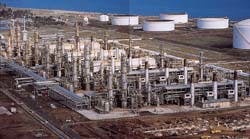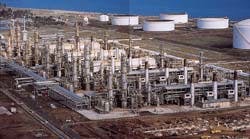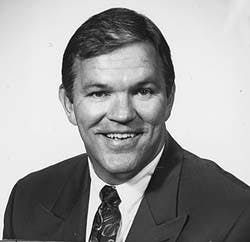LNG links remote supplies and markets
Amos A. Avidan, Robert E. Gardner, Daniel Nelson, Eugene N. Borreli
Mobil LNG Inc.
HoustonTara J. Rethore
Arthur D. Little Inc.
Houston
PT Arun LNG plant shows the immense size a typical plant can attain (Fig. 1).Liquefied natural gas (LNG) has established a niche for itself by matching remote gas supplies to markets that both lacked indigenous gas reserves and felt threatened in the aftermath of the energy crises of the 1970s and 1980s ( Fig. 1).
It has provided a cost-effective energy source for these markets, while also offering an environmentally friendly fuel long before that was fashionable.
The introduction of natural-gas use via LNG in the early years (mostly into France and Japan) has also allowed LNG to play a major role in developing gas infrastructure.
Today, natural gas, often supplied as LNG, is particularly well-suited for use in the combined cycle technology used in independent power generation projects (IPPs).
Here are some typical numbers:
- Proven world gas reserves are of the same order of magnitude as crude oil, about 140 trillion cu m, enough to last about 70 years at current rate of use. Much more gas remains to be discovered.
- LNG is more specialty hydrocarbon than commodity. It is purchased mostly under long-term contracts, as long as 25 years.
- A typical grassroots LNG project, supplying 6 million tons of LNG a year, may cost as much as $5-10 billion, including field development, gas production, gas treatment, liquefaction, shipping, receiving terminal and regasification, and a power plant.
Financing LNG projects, especially when the market includes emerging economies, presents unique challenges.
- The LNG fleet, consisting of 99 ships, has accumulated an enviable safety and reliability record in more than 23,000 voyages.
- LNG liquefaction technology has also accumulated an outstanding safety record and accomplished significant cost reductions. The cost of liquefaction has gone down by about 50% in the past 20 years as train sizes have increased.1
Natural gas and LNG have a natural fit with new efficient combined-cycle power plants.
Today, LNG players cannot simply focus on monetizing gas resources. Instead, they must adapt their projects to meet the needs of changing markets.
The impact of these changes on the LNG industry has been felt throughout the value chain from finding and producing gas, gas treatment, liquefaction, transport as a liquid, receiving terminals and regasification, and finally, to consumption by power producers, industrial users, and households.
These factors have influenced the evolution of the LNG industry and have implications for the future of LNG, particularly in the context of worldwide natural gas.
Early efforts
References to LNG can be found as early as the 19th Century, as advances in cryogenics allowed the liquefaction of light gases, including methane.
The amounts involved were small, until commercial factors drove the large-scale separation of helium in the 1930s. Commercial use of LNG began much later, during World War II.
At that time, insufficient knowledge and experience with cryogenic materials ultimately resulted in a serious safety incident: an LNG storage tank ruptured in Cincinnati in 1944. The cause of this incident was traced to improper metallurgy, 3.5% Ni steel vs. the subsequent standard of 9% Ni.
Efforts to commercialize wide use of LNG were resumed in the 1950s, and an experimental LNG carrier, the Methane Pioneer, was outfitted. Peak-shaving plants in the U.S. were constructed in the 1960s.
A new idea for a large baseload LNG supply plant, coupled with use of the cold, was first articulated by the Chicago Stockyards.
The idea was to use the heat energy inherent in natural gas to generate steam and electricity, while also accessing its inherent cold for refrigeration.
Although the Chicago Stockyard-Conoco LNG venture ("Constock") never materialized, this idea has been used subsequently (for freezing fish in Japan, rather than beef in Chicago) and is still improving the economics of LNG projects.
Algeria was the first commercial LNG exporting country. The first shipments were made to British Gas in 1964 and Gaz de France in 1965.
Sonatrach, the Algerian national gas company, has also entered into agreements with a U.S. gas company, El Paso Natural Gas Co., for supplying LNG to the U.S. in the 1970s. For various reasons, this agreement has not resulted in a long-term supply relationship.
Sonatrach also entered into supply agreements with Distrigas (Everett, Mass., terminal), and Panhandle Eastern (Lake Charles, La., terminal). In recent years, most Algerian LNG has been supplied to Europe.
The Pacific LNG trade was born from the efforts of Tokyo Gas and Tokyo Electric to take LNG to Japan in the 1960s. The first Pacific contract was the Phillips/Marathon Kenai Alaska project in 1969, followed by Brunei LNG in 1972.
The first Middle Eastern LNG supplied to the Pacific region was from Abu Dhabi in 1977 and more recently from Qatar.
The chain
The LNG value chain (Fig. 2 [28037 bytes]) consists of five elements:
1. Finding and producing gas
2. Gas treatment and liquefaction
3. Transport as a liquid
4. Receipt in terminals for storage and regasification
5. Consumption by power producers, industrial users, and households.
Finding, producing
In 1960, world gas supplies were estimated to last for 35 years at unchanged annual consumption levels.
Today, annual worldwide gas consumption is approximately ten times higher, but reserves are estimated to last 70 years at current consumption levels.1
Technology has had a major impact on this growth.
Liquefaction
Liquefaction allows natural gas to be transported effectively to distant markets.
Producers are usually responsible for building the liquefaction plants and loading terminals and have located them relatively close to their natural-gas discoveries.
Investment in liquefaction accounts for 25-35% of the overall capital cost of an LNG project.
Operating LNG plants are listed in Table 1 [54480 bytes] along with approximate current capacity which may show significant expansion, and start date of the original plant.
LNG exports totaled about 73.5 million tons in 1995 (or the equivalent of about 95 billion cu m). The world's newest LNG plant started operating late last year in Qatar (Qatargas).
Known extensions of existing plants and new plants are shown in Table 2 [25794 bytes].
Shipping
Shipping entails use of specialized cryogenic tankers to transport liquefied gas under atmospheric pressure over long distances.
Investment requirements for new ships can amount to 15-25% of LNG chain costs, depending on the distance and number of vessels required. Ownership and control of the ships vary according to the commercial arrangements for each project.
Receiving, regasification
Receiving terminals allow liquefied natural gas to be received, stored, and regasified for use in the same way that piped gas is consumed.
Historically, buyers have been responsible for contributing the capital required to construct the receiving terminal which can account for approximately 5-15% of the total capital investment in the LNG project.
Emerging markets are likely to see involvement of fully integrated LNG companies and others in receiving terminals. Existing and new LNG receiving and regasification terminals in Japan are listed in Table 3 [81578 bytes]. Those in the rest of the world are shown in Table 4 [66116 bytes].
Consumption
LNG is marketed in a fundamentally different way from other hydrocarbon fuels, particularly crude oil and products.
Crude oil is mostly a fungible commodity. It is not unusual for a cargo of crude oil to change hands several times as the oil carrier is in transit or to be sold and re-sold far before it is even produced.
Conversely, traditional LNG projects have been characterized by long-term commitments between buyers, transporters, and suppliers. Under this philosophy, 20-year or longer contracts are the norm.
And, because each LNG project is unique and the financial commitments are immense, it may take years to align all the elements of the project. Historically, securing a buyer has been the critical step for producers to establish an LNG project.
With a long-term sales agreement in hand, the producer/seller may secure financing for development of its supply and liquefaction, as well as contract for construction of dedicated LNG ships.
Interdependency
The uniqueness of each project, plus the symbiotic relationship that traditionally exists between the various LNG value-chain elements, results in a complicated process for creating successful LNG projects.
Each project presents unique challenges, that may take from 2 to 20 years to resolve.
Some key issues project developers face include securing long-term demand, dealing with seasonal demand variations, creating a pricing structure that balances risks between buyer and seller, obtaining financing, securing ships, constructing the various infrastructure, and developing sufficient upstream reserves to support the project for 20 or more years.
Many seasoned players in the LNG industry have looked back at successful LNG projects and wondered how they ever came about.
LNG pricing
In the 1960s, the price of Algerian LNG was primarily determined by the cost to produce it.
Starting in 1973, LNG began to be priced at a level similar to liquid hydrocarbons on a BTU-equivalent basis. This practice is sometimes referred to as "Oil Indexation."
In this approach, the LNG price is proportional to crude oil plus an inflation factor. Producers have tended to use different hydrocarbon reference prices depending on the geographic locations of their customers.
For example, Algerian exports to Europe have used hydrocarbon baskets consisting of crude-oil netbacks and finished products such as distillates and fuel oils. In the Far East, the Japanese Customs Cleared (JCC) price, the average price of crude oils imported into Japan each month, is a very commonly used index.
The majority of LNG sold today has pricing that is indexed to oil.
As the LNG industry grows and evolves, alternatives to the traditional pricing mechanisms may be needed to meet the requirements of both buyers and sellers.
Price formulas incorporating many risk-management features previously limited to finished products such as jet fuel and heating oil may begin to emerge. Examples include caps, floors, collars, and S-curves (Fig. 3 [36368 bytes]).
In addition, sales either on a fixed-price basis or linked to inflation may also be possible.
LNG may need to compete with alternative fuels on a total cost basis in addition to being more environmentally friendly. For example, coal is a competing fuel for power generation.
If the LNG price is linked to the price of the coal, a customer can be assured that the cost to generate power using LNG will always be competitive with the alternative of building a coal-fired plant.
LNG economics
In Asia, LNG is priced at approximate price equity with crude oil on a BTU basis. For the traditional Asian LNG markets (especially the world's largest market, Japan), LNG is the only significant source of natural gas.
LNG competes with pipeline gas in several markets. In Europe, LNG co-exists with pipelines carrying natural gas from a variety of suppliers.
LNG complements pipeline gas, when it is cost effective, and provides for diversity of supply. The most attractive and rapidly developing LNG market in Europe is the Mediterranean region and Turkey.
In North America, where natural gas is ample and an extensive pipeline grid exists, LNG is mostly a peak-shaving operation.
There are more than 100 peak-shaving operations by utilities, and the two operational large LNG terminals on the U.S. Atlantic Coast also operate more as peak-shaving storage.
A small amount of LNG is sold under short-term contracts, typically about 5 billion cu m (or about 5% of LNG trade). This market exists because of excess capacity in existing LNG plants.
Plants are sized conservatively with a primary focus on uninterrupted deliverability to meet contracted supply commitments. When they are properly maintained and with relatively low cost debottlenecks, most LNG plants can produce excess, uncontracted capacity.
Technological innovations also allow continuous debottlenecking. For example, the Arun liquefaction plant train size has been increased to 140% of original design.
Major debottlenecks usually result in new long-term contracts, whereas smaller amounts are sold under short-term contracts or under amendments to base contracts.
Technology's role
Initially, technology enabled LNG plants to run safely, efficiently, and cost-effectively. As the market continues to evolve, technology must play a greater role in creating innovative solutions to complex challenges.
Significant cost reductions have taken place in LNG projects, mostly resulting from train-size increases, increased competition, and better project execution.
Potential for significant cost reductions remains in all elements of the chain. One promising area for further optimization is better use of the cold, thereby closing the circle to the idea of freezing beef in Chicago.
There are many other possibilities for integration between an LNG facility and a combined-cycle power plant. These include:
- Power plant cooling water-LNG vaporization integration
- Utilities and common facilities integration
- Power supply to LNG terminal and revaporization.
Some of the other many diverse uses of the LNG cold are illustrated in Fig. 4 [45000 bytes].2 Many of them have been practiced at Japanese LNG terminals for many years.
Typically, a maximum of about 25% of LNG cold is used for these applications for two main reasons:
1. LNG sendoff rate from a terminal varies considerably (seasonally and hourly). 2. The amount of land adjacent an LNG storage facility is limited to only so many concurrent applications. These vary from power generation, through air separation, to freezing fish and recycling of plastics.
References
1. Commichau, A., "Cost reductions in the Gas Chain-An Economic Necessity," 11th Annual European Autumn Gas Conference, Copenhagen, Nov. 5, 1996. 2. Chapman, J.L., "Hands Across the Sea-The Story of Indonesian LNG," produced by Pertamina, Jakarta, 1985.The Authors
Amos A. Avidan
Robert E. Gardner
Daniel Nelson
Eugene N. Borrelli
Tara J. Rethore
Copyright 1997 Oil & Gas Journal. All Rights Reserved.






